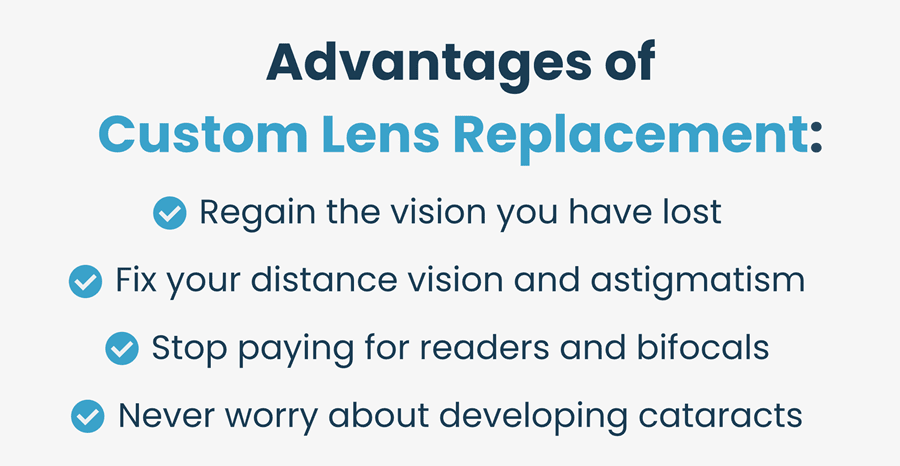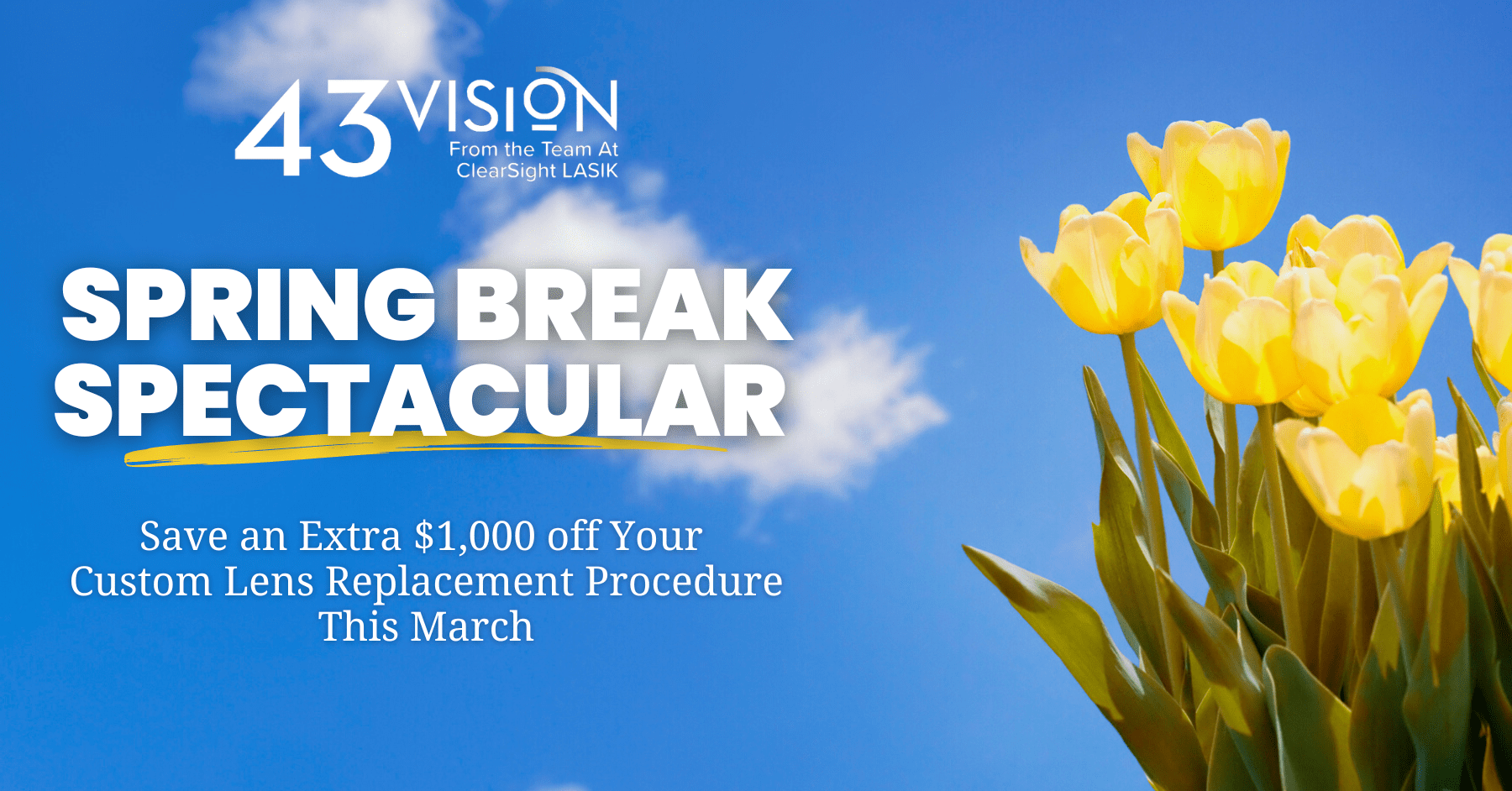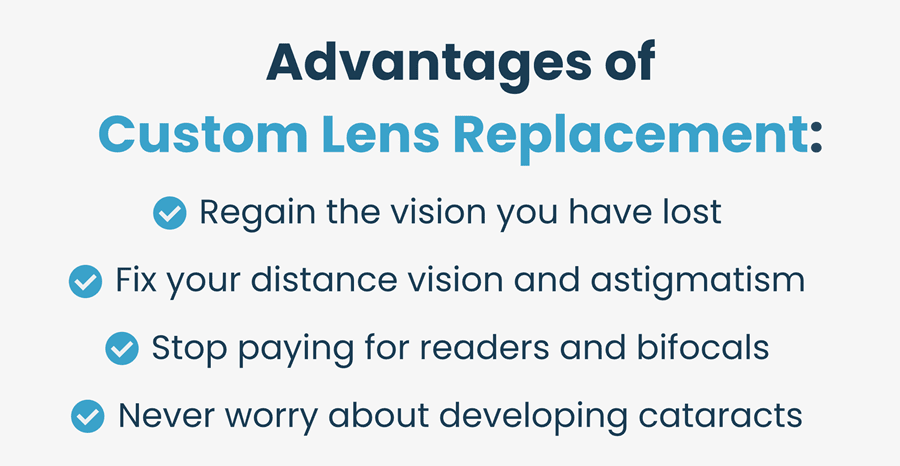Cataracts affect the vast majority of the population, and they form when the lens of the eye becomes clouded or opaque. When you’re born, the lens is transparent, flexible, and focuses light onto the retina in the back of the eye. This focusing results in clear vision. But with more birthdays, proteins within the lens clump and cloud the lens, making it difficult to see details.
Cataracts develop slowly over time, and vision loss may not be noticeable until the cataract has advanced significantly. Cataracts can manifest as blurred or cloudy vision, difficulties seeing at night or in low light, and yellowing or fading of colors.
Cataracts are very common, particularly among the older population. Additional risk factors for cataract development include diabetes, smoking, prolonged exposure to sunlight, and certain drugs such as steroids. Cataracts may sometimes be present at birth or develop due to an injury, eye disease, or other eye health problems.
Thankfully, cataracts and the visual loss they cause are reversible with minimally invasive surgery. Cataract surgery involves replacing the clouded lens with a new artificial lens that doesn’t go bad. The cataract removal and lens implantation procedure is quick, painless, and safe. The majority of patients experience significant vision recovery after the procedure.
Despite its safety and high success rate, anxiety in patients undergoing cataract surgery is very common. Anxiety associated with cataract surgery is one of the main reasons candidates for cataract surgery delay surgery. At 43Vision, we encourage our patients not to let the fear and anxiety of surgery increase worry.
In this article, we will discuss thirteen knowledge points that will give you peace of mind and reduce your fear and anxiety before your cataract surgery.
#1 Cataract surgery is a routine procedure that is extremely safe.
Millions of cataract surgeries are performed annually in the United States, making cataract surgery one of the most frequently performed surgical procedures worldwide. The procedure is low risk and has an over 95% satisfaction rate. Knowing the success rate of your eye doctor, their eye surgery success, and their cataract surgery frequency will help ease any stress or anxiety related with cataract surgery.
#2: Surgery to remove cataracts is painless.
One of the most prevalent concerns regarding cataract surgery is whether or not it will hurt. The good news is that cataract surgery is performed without discomfort. Local anesthetic will be used to numb your eye, so you will not feel any pain throughout surgery.
#3 You won’t see your surgery happening.
You will be given medication to help you relax, and you will be relaxed but awake during cataract surgery. Your skin will be cleaned and eye will be covered with a sterile drape throughout the operation. You will see lights and hear sounds, but you will not have visual perception of what is happening during your procedure. Therefore, you won’t have anxiety associated with anything making you more nervous during the procedure. Your surgical team may play music that you like to reduce the fear and anxiety associated with being in the operating room. A very small percentage of patients require intravenous sedation, but anesthesia is something you can discuss with your doctor during your consultation.
#4 The routine cataract surgery procedure is brief
Cataract surgery and is a brief process. The entire cataract treatment process often lasts between 10 and 15 minutes per eye. This means that you won’t have much time in the operating room. The entire cataract treatment procedure is quick, and you’ll be on your way to better vision and health in a few short minutes.
#5 You can return home the same day
Cataract surgery under local anesthetic is an outpatient procedure, meaning you can return home the same day. Your vision will be hazy for a few hours (and you will still feel sedated), so you will need a ride home, but you will not be required to stay the night in a hospital. You will be given a simple medicated eye drop to use for healing.
#6 Following surgery, you will need to take it easy for a few days.
Although cataract surgery is a simple and safe process, you will need to take it easy for a short time after the procedure. After any local anesthetic procedure, you should return home and rest. You will be given advice on how to care for your eyes following surgery, and you will need to avoid activities such as heavy lifting or bending for 1 week to ensure that the lens remains in place. You will be using eye drops during the healing process. Within a few days, you will be able to resume the majority of your routine activities.
#7 Your eyesight will improve rapidly
Following cataract surgery, your eyesight will improve rapidly. The majority of patients should be able to return to most of their routine activities within a few days. However, it may take several weeks for your vision to stabilize and your visual acuity to reach its maximum potential.
#8 You should wear sunglasses for several days.
Most eye doctors require their patients to wear sunglasses after cataract surgery to protect the eyes while they heal. Your physician will provide you with instructions on how to wear them and for how long.
#9 Rarely do complications arise
Cataract surgery complications are uncommon, but they can arise. The most frequent problem is a secondary cataract or residual refractive error, which develops when the lens capsule becomes cloudy or the eye has leftover correction. This is easily remedied using a laser procedure or laser vision correction, respectively. Additional uncommon side effects following a routine cataract surgery include infection, bleeding, dry eye, swelling, and need for enhancement. The good news is that the risk of complications is extremely minimal, especially when an experienced surgeon is used.
#10 You’ll need to schedule some follow-up visits.
You will need to attend follow-up consultations with your eye doctor to check that your eyes are healing properly after cataract surgery. These appointments are essential for monitoring your vision and detecting any potential issues. Your doctor will inform you of the frequency of your follow-up appointments.
#11 You may still require glasses following surgery.
Most of our patients do not need glasses for any tasks after surgery at 43 Vision. Depending on your unique circumstances and the type of intraocular lens (IOL) used during your operation, you may still require glasses for certain activities, such as reading fine print or night driving. Your doctor will review your specific needs and help you determine if you will require glasses after surgery.
#12 You can ask questions and raise concerns
It’s totally normal to feel nervous or anxious before cataract surgery, and it’s vital to discuss any concerns or feelings you may have with your doctor. By simply having a conversation with you, your physician can give you information regarding the process, which can help with reducing anxiety. Feel free to speak up and ask questions, as doing so will lessen worry and stress significantly. At 43Vision, we provide all of our cataract surgery patients with preoperative education and counseling and will spend as much time as necessary answering their concerns and ensuring they are satisfied with their decision to undergo cataract surgery. Our goal is to alleviate patients negative emotions and have them confident, hopeful, and excited about the improved vision they will have after the cataract treatment process is complete.
#13 The advantages of cataract surgery outweigh its risks.
Although there are risks involved with any surgery, the benefits of improved vision following cataract surgery outweigh the risks for the vast majority of patients. Cataract surgery can greatly enhance your vision and quality of life, enabling you to participate in activities that you previously could not. You may help ensure a safe and effective surgery by taking the appropriate precautions, following your doctor’s recommendations, and maintaining routine comprehensive eye examinations.
Our objective at 43Vision is to better our patients’ lives through innovative vision correction and cataract surgery. Our team of fellowship-trained ophthalmologists provide advanced vision correction operations to patients of all ages. Contact our office today to arrange your comprehensive eye exam and consultation, and you’ll be on the path to clear vision in no time.
source https://www.43vision.com/blog/nervous-about-cataract-surgery-13-things-you-should-know-that-will-give-you-ease-of-mind/








